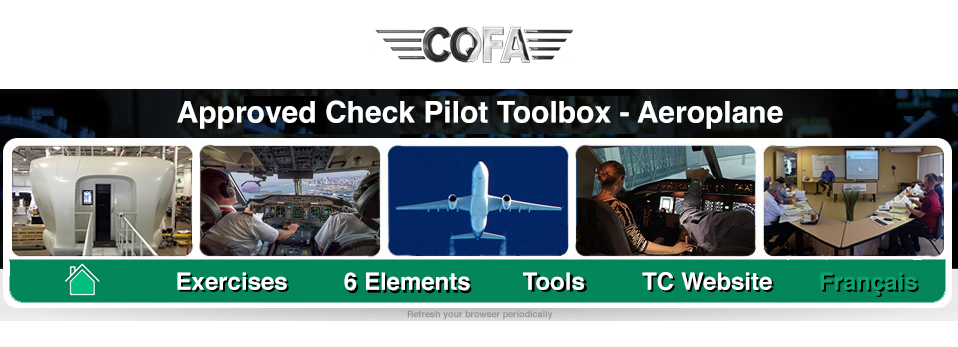3. Pre-flight (PRF)
Aim
Determine the candidate’s ability to systematically complete internal and external checks in accordance with the POH/AFM and SOP’s to ensure that the aeroplane is ready for the intended flight. The candidate will also demonstrate knowledge of how to deal with irregularities, if found.
Description
The candidate will determine that the aeroplane is ready for the intended flight. The pre-flight aeroplane inspection will include a visual inspection of the exterior and interior of the aeroplane, locating each required item and explaining the purpose of the inspection in accordance with the POH/AFM and SOP’s.
The candidate will carry out in accordance with the POH/AFM a visual check for fuel quantity, proper grade of fuel, fuel contamination and oil levels. If, due to aircraft design, the POH/AFM does not prescribe a visual check of fuel levels, the candidate will use fuel chits, fuel logs or other credible procedures to confirm the amount of fuel on board the aircraft.
At the request of the ACP, the candidate will conduct an oral passenger safety briefing.
Performance Criteria
(06/2017 FTG p.18-19) Assess on the candidate’s ability to:
- demonstrate an adequate knowledge of the pre-flight inspection procedures, while explaining briefly the purpose of inspecting the items, which must be checked, how to detect possible defects and the corrective action to take;
- demonstrate adequate knowledge of the operational status of the aeroplane by locating and explaining the significance and importance of related documents, such as airworthiness and registration certificates, operating limitations, handbooks, and manuals, minimum equipment list (MEL) (if appropriate), weight and balance data and maintenance requirements, tests, and appropriate records applicable to the proposed flight or operation; and maintenance that may be performed by the pilot or other designated crewmember;
- use the approved checklist to inspect the aeroplane externally and internally;
- use the challenge-and-response (or other approved) method with the other crewmember(s), where applicable to accomplish the checklist procedures;
- verifiy the aeroplane is safe for flight by emphasizing (as appropriate) the need to look at and explain the purpose of inspecting items, such as:
- powerplant, including controls and indicators 16
- fuel quantity, grade, type, contamination safeguards, and servicing procedures
- oil quantity, grade, and type
- hydraulic fluid quantity, grade, type, and servicing procedures
- oxygen quantity, pressures, servicing procedures, and associated systems and equipment for crew and passengers
- hull, landing gear, float devices, brakes, and steering system
- tires for condition, inflation, and correct mounting, where applicable
- fire protection/detection systems for proper operation, servicing, pressures, and discharge indications
pneumatic system pressures and servicing- ground environmental systems for proper servicing and operation
- auxiliary power unit (APU) for servicing and operation
- flight control systems including trim, spoilers, and leading/trailing edge
- anti-ice, deice systems, ice warning systems, servicing, and operation
- coordinate with ground crew and ensure adequate clearance prior to moving any devices, such as door, hatches and flight control surfaces;
- comply with the provisions of the appropriate Operations Specifications, if applicable, as they pertain to the particular aeroplane and operation;
- demonstrate proper operation of all applicable aeroplane systems;
- note any discrepancies, determine if the aeroplane is airworthy and safe for flight, or takes the proper corrective action with respect to unsatisfactory conditions identified; and
- check the general area around the aeroplane for hazards to the safety of the aeroplane and personnel.
Commenting a "1"
- Incomplete/omitted walk-around. Unable to demonstrate knowledge of what to check and why.
- Incorrect knowledge of aircraft system limitations (fluids, pressures, wear signs, etc)
- Unable to determine if aircraft is serviceable.
- Did not enquire about aircraft serviceability with ground crew/maintenance.
- Did not check/confirm cargo was secure, or loaded according to load data/AFM.
- Did not process Hazmat information as per SOP.
- Unable to communicate with ground crew as per SOP
- Did not process surface contamination situation as per SOP. Unable to determine if de-icing is required.
- Unable to determine de-icing fluid holdover time.
- Incorrect use/understanding of MEL.
- Incorrect use of supplied checklists.
- Cockpit checks not completed as per SOP. Used personal checks/techniques not compatible with SOP.
- Systems activation/displacement without insuring adequate ground crew safety.
- Did not report system malfunctions in company documents.
Commenting a "2"
- Difficulty completing walk-around, or required assistance to verify system status.
- Limited knowledge of aircraft systems required the support of aircraft documents/other crewmember.
- Determination of aircraft serviceability required several prompts/consultations of aircraft documents/other crewmembers.
- Verified cargo load against Load Figures/data/AFM only after prompting by company personnel.
- Required support from company personnel/other crewmember to adequately assess loaded Hazmat.
- Coordination with ground crew not as per SOP generating initial confusion/questions, but resolved before departure.
- Limited knowledge of de-icing fluids holdover time. Required support from other crewmember.
- Laborious use of MEL generating confusion/errors. Corrected before departure.
- Use of checklist often interrupted generating confusion/questions by other crewmember.
- Cockpit checks completed out of sequence.
- Unclear communication with ground crew before system activation/displacement.
- Logbook discipline generated confusion/questions/departure delay.
